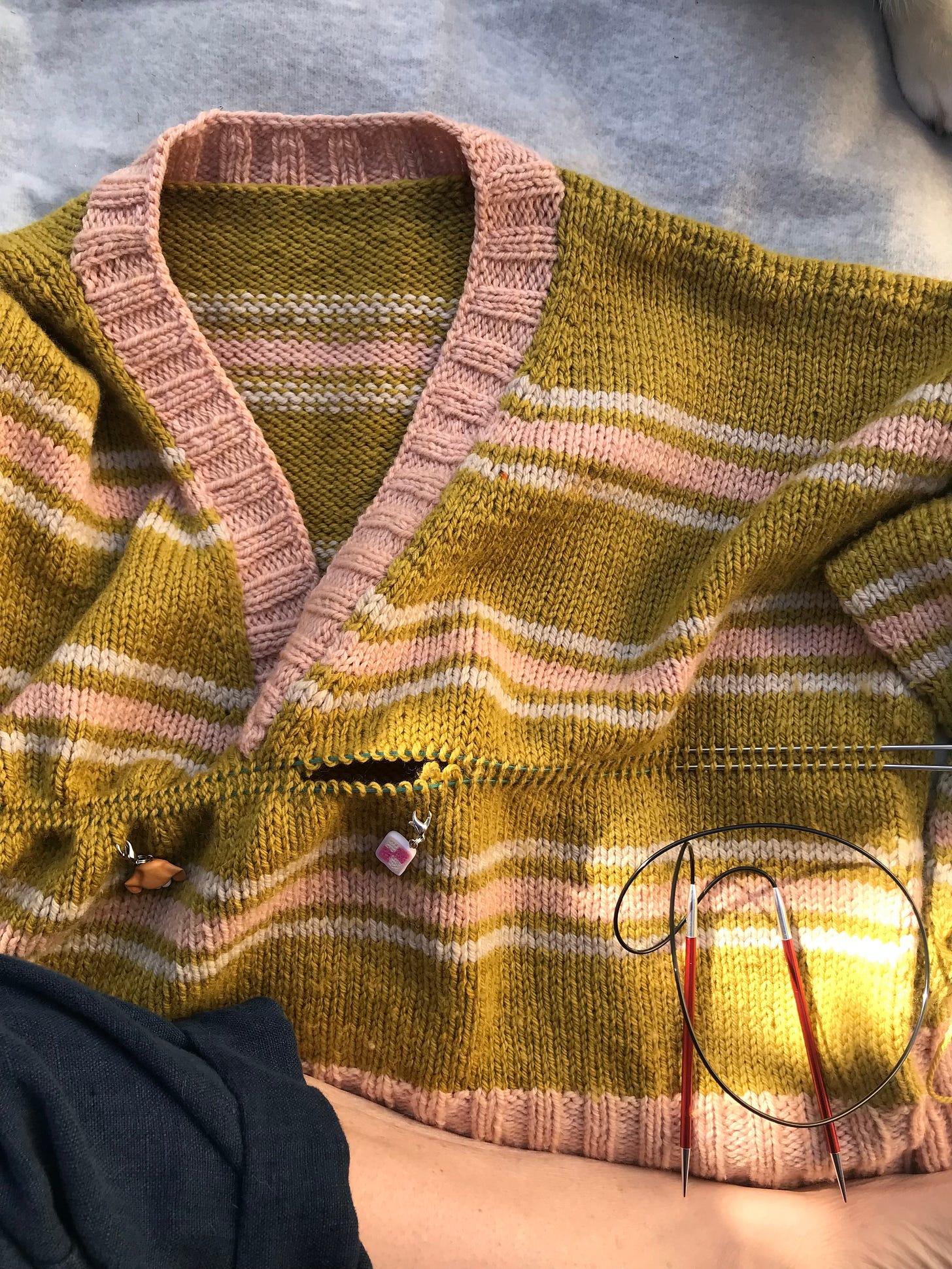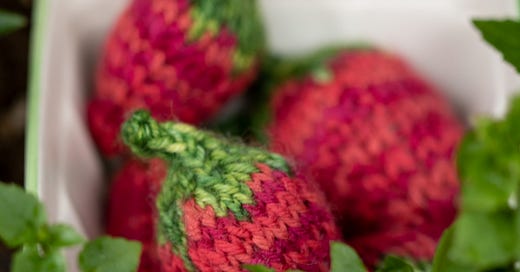What is your knitting origin story?
This is how I became a knitter with a capital K. What was your path?
We all have a knitting origin story.
Michelle Obama famously become a knitter during the start of the pandemic in 2020.
Some of us have been knitting since we were very young children, learning from mothers or grandmothers.
I don’t even remember learning how to knit. It’s like my fingers have just always known how.
I briefly dabbled with knitting in my early 20s but it was more like people watching than an urge to knit. I was content to browse a yarn shop or imagine the beautiful blanket I might create for someone else’s new baby, but I couldn’t muster the long-term energy to stick to a project. I’d be content with a yarn purchase, a few stitches, a cast-on, maybe an afternoon of knitting, and then the barely-started project would join others in a bag or bin, deep in the closet.
I became a knitter after my son was born, a year or two after I emerged from postpartum depression. I’m not going to share my postpartum story today, but it occurs to me, now, that this connection of knitting to being in, or emerging, from tough times is a common thread for many of us.
After being a colicky newborn, my son turned into a good sleeper as a baby (for which I will always be grateful) and he fell asleep reliably around 6 each evening. As my postpartum depression lifted, and as he and I began to deeply bond, connect and revel in one another, I would miss him during those evening hours when he was asleep. So I would do baby-adjacent projects. I’d make baby food, research toys, preview picture books, and generally do things to feel connected to him. When he was around 2, he became deeply interested in play kitchens and food play. I remember seeing a picture of knitted strawberries and thought to myself: I could make that.
And so I did.
I went to my local yarn shop, purchased a gorgeous skein of strawberry-colored yarn and perfect green leaf-colored yarn, found a pattern, and, in the evening hours while my boy slept, I struggled through remembering how to knit. Fueled my mama-love, I worked small stitches on double-pointed needles, in the round, and created three-dimensional objects.
A hobby that tapped my lifelong joy of craft and art, and that also helped me feel connected to my baby, was exactly the balm I needed.
Every night, for weeks and weeks, I worked on knitted fruit for his play kitchen. I knit a basket of strawberries. A banana. An apple, and an orange. Vegetables like an eggplant and a carrot.
I branched out to toddler hats and vests (which he never really liked to wear, because he as particularly particular about how things feel on his body), but by then, knitting for connection to my boy wasn’t as important to me as simply knitting.
I loved the process of stitch upon stitch, and I loved making something for myself to wear. I loved learning how to make sweaters and shawls that were higher quality than anything I could find in stores and the style of which were a unique expression of me. I still love knitting for all of these reasons, and for more.
Since those years as a young mother, I have had later bouts of depression—and anxiety too—and knitting has seen me through. Like Michelle Obama, I find that knitting is a small thing but one that soothes me and teaches me endlessly.
Small things matter. Things can be mended. Feeling better is sometimes a slow process but, just like stitches being worked, one after another, it is a process, and nothing horrible lasts forever. I can breathe, and tolerate, and exhale, and grow.
What is your knitting origin story? I would love to know.
Something I’m making: a vision of a different way of doing business
I don’t have any yarn in my shop right now because I’m waiting for a 50-pound box of base yarn to get here. It’s currently overdue and stuck in Buffalo, New York. While I wait for it, I’ve been reflecting on why I started Little Skein back in 2013.

Back when I started Little Skein, I had a newly-minted kindergartener, ambitious work that required a lot of face time in the office and a longing to not miss out on my kid’s school years by rushing from work to pick-up times to bedtime.
I created Little Skein in the hopes of replacing my salary and having the kind of flexibility that parents need in order to care for themselves and their children without going batshit crazy. I wanted to continue to embrace ambitious creative work, just in a slower way.
I never quite reached my income goal by the time the pandemic hit in 2020, but I was earning enough while also running a business that was firmly aligned with my values of fair pay for makers, sharing revenue, and creating inclusive spaces in more than name only.
For the better part of the pandemic, I’ve been more inward, tending to myself and family health and scaling back my business. It’s also fair to say that I’m slowly feeling better and am turning outward, again. Regaining one’s footing after big changes—whether that’s becoming a mother or surviving a global pandemic—is that slow, slow process of stitches over stitches, progress that looks for a time like it isn’t going anywhere, and starting to dream and imagine good things, all over again.
I want to let you in on a dream I’ve been nurturing for a little while now.
I am retooling Little Skein to be more sustainable for the me who exists now, and I’d like it to earn a good-enough income again. On the surface, this means more yarn in the shop, but more yarn in a volume that’s sustainable for my body.
It means working solo, rather than growing, because that’s what feels right for me, right now.
And, deeper down, and much more tenderly, I hope to earn part of my income from my writing and this newsletter. (The newsletter is still free, but I will soon turn on paid subscriptions as a tip jar, and eventually, for-real paid subscriptions with some of my writing for free and some behind a paywall.)
I hope you’ll be rooting for me.
A well-wish
We’ve all been through big and deep things, especially these last number of years. Persisting in the face of difficulty, losing and regaining our hope, knitting through tough times, these things are part of all of us.
I hope that where-ever you are in this cycle, whether it is fully embodying hope or being in that slow process of recovery or even just trying to breathe and hold on, I wish for all of us: good things we can’t even yet imagine. Stitch over stitch, slow progress, and hope, all over again.
P.S. I hope you’ll share your knitting origin story with me below!








I knit because knitting sustains me. it is an outlet, a refuge, a community. It's been 20ish years after wanting to learn for a while. Glad I stepped out. Especially during the times we are in now, it seems as necessary as breath.
thank you for sharing your story.
I became a knitter again years back when my fingers itched to do something creative. Recently, I used it to calm myself during my husbands long battle with illness. Lately though it is hard to concentrate on anything as he died a few days ago. I love reading you newsletters, they provide a welcome distraction. I like that you are real and honest about your feelings.